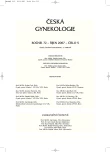-
Medical journals
- Career
Sperm Banking before Gonadotoxic Treatment – 11-years Experience
Authors: I. Crha 1; P. Ventruba 1; J. Žáková 1; B. Kubešová 2; Jiří Jarkovský 3; Martin Huser 1
Authors‘ workplace: Gynekologicko–porodnická klinika Masarykovy univerzity a FN Brno přednosta prof. MUDr. P. Ventruba, DrSc. 1; Tkáňová banka FN Brno, přednostka prim. MUDr. B. Kubešová 2; Institut biostatistiky a analýz Masarykovy univerzity, přednosta doc. RNDr. L. Dušek, PhD. 3
Published in: Ceska Gynekol 2007; 72(5): 320-326
Category: Original Article
Overview
Introduction:
The aim of this study was to analyze possible relation of sperm pathology and diagnosis of malignant disease and present our experience of sperm banking programme for cancer patients.Design:
Retrospective clinical study.Setting:
Department of Obstetrics and Gynecology, Masaryk University, Brno.Material and methods:
521 patients (age 26.0±6.7 years) were referred to our unit by oncology specialists for semen cryopreservation before cancer treatment during 1995–2005. Sperm samples obtained by masturbation were analysed according to guidelines of WHO. Cryoprotective medium and Planer Kryo F 10 were used for standard cryopreservation. National cancer register was used to analyze patients survival. Basic statistics was used for data description and relations among sperm parameters and diagnosis were tested by Kruskal-Wallis ANOVA. Standard intracytoplasmic sperm injection (ICSI) using frozen spermatozoa was used for infertility treatment following malignant disease recovery.Results:
Testicular cancer was diagnosed in 45.7% patients, malignant disease of lymphatic and haemopoetic tissue in 32.0% cases – out of them 16.5% Hodgkinęs lymphoma. Sperm concentration ≥ 20 mil/ml had 45.9% men. Severe oligospermia ≤ 1 mil/ml was found in 23.2% men and azoospermia in 10.0% patients. Severe asthenospermia ≤10% was in 60,8% men. Sperms were retrieved in 76.7% of 30 boys 14 to 16 years old, in 46.7% was concentration lower than 1 mil/ml and in 26.1% sperm motility lower than 1%. Sperm concentration was significantly lower in men with testicular cancer (p = 0.002), differences in sperm motility were insignificant. Cryopreserved samples were used in 30 patients (5.8%), 22 of them in our centre. Intracytoplasmatic sperm injection was used in all cases, 7 clinical pregnancies (31.8%) and 5 deliveries were achieved. In the group of all patients died 62 men (11.9%).Conclusion:
Cancer patients have high frequency of severe sperm pathology. The lowest sperm concentration was in men with testicular cancer. Only minority of patients return for fertility treatment. Cryopreserved spermatozoa of cancer patients are able to achieve pregnancy by assisted reproduction techniques.Key words:
cancer, semen cryopreservation, chemotherapy, male infertility, assisted reproduction techniques
Labels
Paediatric gynaecology Gynaecology and obstetrics Reproduction medicine
Article was published inCzech Gynaecology

2007 Issue 5-
All articles in this issue
- Inherited Metabolic Disorders and Pregnancy
- Sperm Banking before Gonadotoxic Treatment – 11-years Experience
- Lycopene Therapy in Male Infertility
- Socioeconomic Datas, the Course of Pregnancy and Delivery in Opioid-addicted Women and Women under Substitution Therapy
- Prediction of Preeclampsia Using the Integrated Test Markers
- Determination Concentrations of Tissue Factor Pathway Inhibitor and their Changes during Estrogen Replacement Therapy
- Progression and Regression Low Grade Intraepitelial Squamous Lesions in Context of Positivity of High Risk Human Papillomavirus
- Basal-like Carcinoma of the Breast – the Actual Review and Clinico-Pathological Corelations
- Da Vinci Robotic Surgery in Gynaecological Oncology: a Critical Interim Appraisal
- Current Condition of Diagnosis and Therapy of Overactive Urinary Bladder in Czech Republic
- Czech Gynaecology
- Journal archive
- Current issue
- Online only
- About the journal
Most read in this issue- Inherited Metabolic Disorders and Pregnancy
- Basal-like Carcinoma of the Breast – the Actual Review and Clinico-Pathological Corelations
- Da Vinci Robotic Surgery in Gynaecological Oncology: a Critical Interim Appraisal
- Progression and Regression Low Grade Intraepitelial Squamous Lesions in Context of Positivity of High Risk Human Papillomavirus
Login#ADS_BOTTOM_SCRIPTS#Forgotten passwordEnter the email address that you registered with. We will send you instructions on how to set a new password.
- Career

